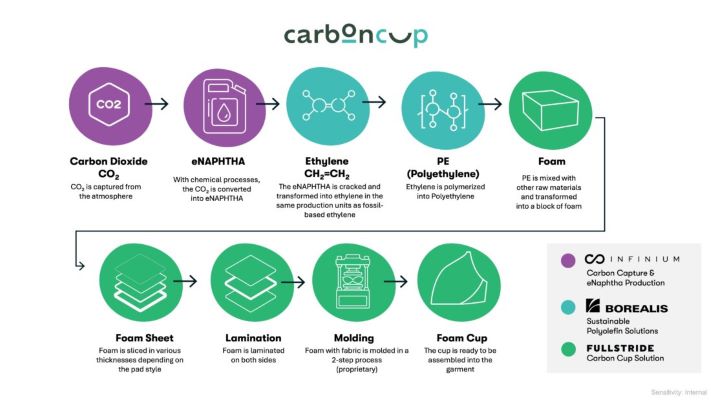The high-performance foam is produced using Borealis’ polymer which is derived from Infinium’s eNaphtha—a low-carbon feedstock made using captured carbon dioxide

The production process from CO2 that is captured from the atmosphere to foam cups. © Fullstride
Borealis, Infinium, and Fullstride Ventures have developed a high-performance foam for the fashion industry using captured CO₂ emissions. The first application is Fullstride’s carboncup bra cup, offering the same comfort and durability as conventional foam but with a significantly lower carbon footprint.
The foam is produced through a multi-step process that begins with capturing waste carbon dioxide (CO₂) that would otherwise be released into the atmosphere. Infinium’s proprietary process transforms this waste CO2 into eNaphtha—a low-carbon, drop-in alternative to fossil-based naphtha.
Borealis then uses the eNaphtha to polymerize into polyethylene, the raw material for foam production. The result is a sustainable high-performance material that is efficiently processed in existing manufacturing and recycling infrastructure, all while meeting the stringent requirements of intimate apparel applications.
Fullstride’s carboncup is the first commercial application of the new foam material, partially made from CO2-derived eNaphtha, where it offers the same comfort, breathability, and long-lasting support as conventional foam, but with a significantly lower carbon footprint compared to the 100% fossil-based polyurethane pads.
Infinium is one of the first companies to supply commercial volumes of eNaphtha to the market, enabling an additional pathway to decarbonizing plastics production and reducing global CO2 emissions.
The carboncup is one of the first outcomes to result from the collaboration announced by Borealis and Infinium in August 2024, when the two companies revealed plans to use Infinium’s eNaphtha to produce low-carbon plastics from captured CO₂. Its launch marks a significant step toward circularity in the apparel industry and shows how collaboration across the value chain can unlock new ways to keep carbon in use and out of the atmosphere.
Subscribe to our newsletter & stay updated.